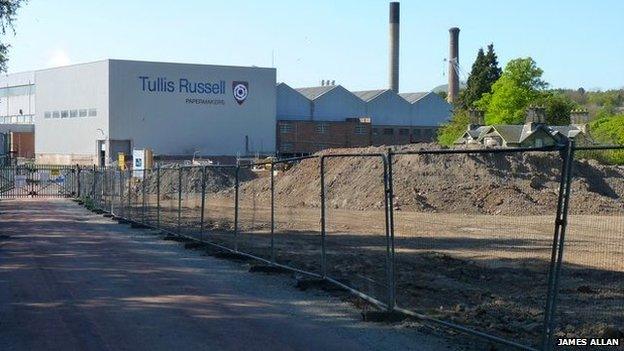More than merely paper losses
- Published

Scotland used to be quite good at making paper. It fed a healthy demand, fuelled by all that world-beating literacy and education.
The industry is thought to have begun in Dalry, Edinburgh, as early as 1590. As a sizeable market, external for paper in government, publishing, commerce, the university and the law courts, the capital continued to dominate, with dozens of mills along the Water of Leith.
By the 1830s, there were more than 70 papermaking plants, a fifth of all the plants in Britain, processing cotton rags. One of them was Tullis Russell, founded in 1809 at Markinch in Fife.
As recently as 1959, there were 17,000 employed in the industry in Scotland, when MPs were debating whether to reduce tariffs on imports from Sweden (an interesting read as a contrast to today's debates about European markets).
Biomass plant
As a big user of energy, Scottish paper mills, 55 years ago, consumed 800,000 tonnes of coal each year, so Markinch was happily located at the heart of the Fife coalfield.

Pulp and paper remains the world's fifth biggest industry for carbon emissions. But the biomass plant, built for £200m next to the modern-day Tullis Russell plant, has come too late.
In a joint project with RWE Npower, it swallowed £8m of Scottish government grant, began work last year and was only officially opened last month.
The biomass may keep burning, as it feeds into the National Grid. But on Monday, 325 staff at Tullis Russell were made redundant, and a further 149 are staying on to complete contacts.
'Think before you print'
The plant simply couldn't withstand the various pressures bearing down on it; the increased price of wood pulp: a major customer going bust: export earnings hurt by the weakened euro against the pound: an industry in decline across Europe.
We are using less of the high quality document and brochure-quality paper and card in which Tullis Russell has specialised. Online publishing and the economic downturn have removed 40% of value from its segment of the market. In the past seven years, its volumes were down 14%.
The email has reduced demand for paper. and we're also using less newsprint - down 7% across Europe last year.
If you make tissue or cardboard, as with the Macfarlane Group in Glasgow, you can still have a healthy business in Britain. But graphic paper-making, as in Markinch, is losing out to structural changes in the market, and cheaper competition. The BRIC countries of Brazil, Russia, India and China have undercut European paper-makers.
There was an attempt to find a trade buyer who could take on the Markinch plant, access new markets or turn it around to produce more efficiently. But of 72 possibles contacted by KPMG on behalf of Tullis Russell directors, none of them thought it viable. Therefore, neither did the directors.
Closure pattern
The demise of Tullis Russell is part of a pattern of closures. It included the International Paper plant in Inverurie, closed five years ago with the loss of 350 jobs, after 157 years in the business.
The Corpach Paper Mill, near Fort William was closed by Arjo Wiggins in 2005, with 135 jobs going. Along with the pulp mill, it had been an important link in the 1960s plan to rejuvenate the Highlands.
The same year, Inveresk closed its last Scottish paper mill, in Denny, having just shut its Inverkeithing plant.
In Aberdeen, the Davidson Mill closed in 2005, with the loss of 276 jobs. Four years before that, 250 jobs went with the Donside Paper Mill in Aberdeen's Muggiemoss.
And Penicuik in Midlothian, claiming the historic title of 'the Papermaking Town', saw the last mill on the River Esk close 11 years ago.
So the Scottish industry is down to Stoneywood in Aberdeen, which began in the 18th century, and the giant Caledonian mill in Irvine, an inward investment opened in 1988.
Worker control
The Tullis Russell closure is not only a blow to the workers who are losing their jobs, but because they are also 70% owners of it. They are at the front of the queue for any back pay, but at the end of the queue for getting anything out of that shareholding.
And while this is a blow for Fife and for manufacturing at scale, it may also be a significant blow to confidence in employee ownership.
Following the collapse, the chief executive who set up Tullis Russell as a worker co-operative in 1994, David Erdal, external, has defended the ownership model.
His family had owned the plant since it started in 1809, and he now stresses that employee ownership is not to blame for the closure. He claims the evidence points, on the contrary, to worker control boosting productivity, innovation and longevity.
But the Markinch closure raises a further question: is it so well suited to recognising market decline in time to provide a strategic response to it?
- Published27 April 2015
